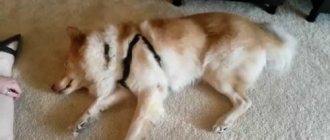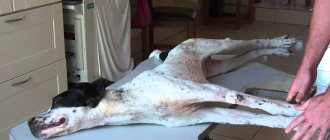Every owner will be concerned if their dog vomits foam. What to do in this case - urgently contact a veterinarian or solve the problem yourself?
Foamy vomiting is not a separate disease. This is a symptom that signals that the dog is unwell or has an illness.
You don't always have to worry about this. Vomiting can be caused by ingestion of poor-quality food or intolerance to any foods. If this is an isolated case, then it should not cause your concerns. If the dog constantly vomits , the pet behaves restlessly, loses its appetite, develops diarrhea or, on the contrary, constipation, then the underlying cause of this condition can be quite serious. In this case, a visit to the veterinarian is mandatory.
Causes of physiological vomiting
Single vomiting occurs in healthy animals. This phenomenon is within the physiological norm, so it does not cause concern for experienced dog breeders. A dog may vomit in the following cases:
- With the help of vomiting, the pet gets rid of excess food eaten or a foreign object that has entered the stomach.
- Excessive white foam at the mouth in small breed dogs is a natural process that occurs due to sensitive digestion. The appearance of such a reaction can be provoked by sudden changes in diet. At the same time, the pet’s general condition does not deteriorate. The dog remains highly active and has an appetite.
- Sometimes white foam is released due to the anatomical structure of the jaw. This is typical for mastiffs, bulldogs and boxers. Saliva constantly flows from their mouth. Bubbles appear due to active movements of the jaw.
- The dog may vomit white foam if there is a long gap between feedings. This is a sign of exhaustion. Hydrochloric acid is constantly produced. Therefore, if the pet is not fed, the gastric juice reacts with the protective mucus in the stomach and passes through the esophagus in the form of white foam.
In some cases, the cause of the appearance of a foamy substance may be stress and severe fear. In such a situation, the excitability of the animal’s nervous system increases, which increases the work of the salivary glands.
REFERENCE. White foam may be released from fatigue after long walks.
Preventing gastrointestinal problems in dogs
Preventive measures aimed at preventing gastrointestinal diseases are divided into nursing and educational. Basic recommendations include:
- Prohibition on picking up garbage. Digging through household trash or street bins can lead to acute poisoning or ingestion of a foreign body. Accustom your pet to prohibition commands from early childhood or give it to a dog handler. At first, you can limit yourself to a muzzle, which prevents picking up dangerous objects.
- Quarterly deworming and annual vaccination. Stay on schedule to prevent these treatments from becoming less effective.
- Accustoming to long trips in transport. Start with short distances and use motion sickness remedies.
- Diet control. Monitor the quality of food, avoid sudden changes in food and overfeeding. Remember that sharp bones can damage the esophagus and intestines.
- Safe storage of medicines and household chemicals. Prevent your pet from having access to the listed substances by placing them in a place inaccessible to him.
Don't ignore any changes in your pet's behavior and attend regular checkups. Timely detection of the problem will eliminate complications and surgical intervention.
The appearance of foamy vomit requires mandatory diagnosis.
Without the help of a veterinarian, it is difficult to figure out the cause on your own, so attempts at home treatment are fraught with aggravation of the pet’s condition. The article is for informational purposes only.
Contact your veterinarian! Do you like the article? 252
Pathological causes and symptoms
If a dog vomits regularly and its condition gradually worsens, this may indicate the development of a pathological process in the body. In such a situation, it is necessary to find out the cause of the appearance of white foam as soon as possible and take the animal to the veterinarian, especially puppies.
When an animal is sick:
- whines;
- licks his lips frequently;
- increased salivation and restless behavior are observed;
- refuses water and drink.
Plague
The cause of vomiting white foam may be the intestinal form of plague. This dangerous infectious disease begins with conjunctivitis and redness of the eyes. The animal begins to hide in dark places, photosensitivity and photophobia are observed. The pet refuses to eat. As the general condition worsens, the clinical picture is complemented by a runny nose, fever and chills, diarrhea, and a sharp increase in temperature to +41°C. Poor stool and vomiting quickly dehydrate the dog’s body and lead to exhaustion.
Rabies
When infected with a deadly infection, the dog burps white viscous foam. In addition to salivation, the dog begins to be afraid of water. As the pathological process progresses, respiratory failure, paralysis of the pharynx and lower jaw are observed. As a result, the dog has problems with swallowing, and the animal tries to eat inedible objects. With rabies, the pet is characterized by increased aggression, so it can bite the owner. To prevent the spread of infection, the animal is isolated and euthanized.
Read Signs and treatments for vitamin deficiency in dogs: 9 vitamins your dog is missing
Epilepsy
If your dog vomits white foam and has seizures, all symptoms indicate the development of epilepsy. When a pathological process occurs, the animal falls, and the dog’s stomach contents are reflexively evacuated. Possible involuntary urination, loss of orientation in space. During a seizure, white foam is constantly released from the mouth.
REFERENCE. Poodles, Labradors and spaniels are susceptible to CNS disease.
Worm infestations
With a parasitic disease, general intoxication of the body occurs. The dog is constantly vomiting, the animal often coughs in the morning. Even with a normal appetite, the animal quickly loses weight. The excrement contains blood and mucous secretions.
Intoxication
When food poisoning occurs, a dog vomits not only white foam, but also green foam. When the body is intoxicated, the animal’s body temperature drops sharply, the pupils are dilated, and the fur looks matted. The pathological condition is accompanied by diarrhea, cramps, lack of appetite and muscle weakness.
Digestive system diseases
If your dog vomits white foam first, and then the color of the vomit changes, this may indicate damage to the digestive system:
- hepatitis;
- ulcerative-erosive disease of the stomach;
- cholecystitis;
- malignant neoplasms on the walls of the gastrointestinal tract.
In addition to color changes, the development of diseases of the digestive system can be indicated by impurities of blood and mucus in a food coma.
First aid
If white foam comes out of the mouth, you should not:
- scold the dog;
- leave it unattended for a long time;
- inject yourself with antiemetic drugs;
- expect the urge to stop on its own.
If vomiting recurs and is accompanied by diarrhea or cramps, take your dog to the vet. During cleaning, inspect the vomit. Tell your doctor about their color, consistency, volume, as well as possible:
- clots of mucus;
- blood impurities;
- food particles;
- foreign object;
- helminths and their eggs.
To make a diagnosis, the veterinarian needs to know about past diseases, diet, and activity of the animal.
Danger of condition
If after the dog vomits, the vomiting of white foam does not stop, the pet begins to feel dehydrated. Together with the food masses, a large amount of liquid leaves the animal’s body. As a result, the water-electrolyte balance, kidney function and circulatory system are disrupted.
The gag reflex prevents food from being absorbed normally, which leads to depletion of internal reserves. This is especially dangerous for puppies and small dog breeds such as the Yorkshire Terrier. In addition, while vomiting, the dog may choke on the food bolus. If food gets into the trachea, it can lead to the death of your pet.
REFERENCE. Yorkies may vomit 1-2 times a week. White foam indicates a violation of food digestion. To solve the problem, you should follow the principles of fractional nutrition and include fatty foods in your dog’s diet.
How is the diagnosis carried out?
Diagnosing a severe cough in a dog is fraught with objective difficulties, since this symptom is characteristic of many diseases and pathological conditions, and their nature can be very different. However, an experienced veterinarian, having examined the animal and interviewed its owner, can, as a rule, significantly narrow the range of possible reasons for the deterioration of the dog’s condition, including by focusing on the additional “tips” listed above.
Did you know? In 2013, in the UK, a 12-year-old boy named Landon Jones was diagnosed with a unique disease, the only symptom of which is a complete absence of hunger and thirst. Until this moment, the child was tormented by a strange cough, which went away over time, but his appetite disappeared suddenly and never returned.
Further actions can be aimed either at confirming the initial assumption, or, if the situation is not entirely clear, at consistently excluding the most likely diseases.
For this purpose, the veterinarian may prescribe the following diagnostic procedures:
- clinical blood test;
- biochemical blood test (including to determine the concentration of bile acids in the serum);
- chemical-toxicological blood test;
- Analysis of urine;
- stool analysis;
- PCR (polymerase chain reaction) analysis to determine viral infection;
- radiography (fluoroscopy) of the chest;
- gastroscopy;
- ultrasound examination of internal organs;
- echocardiography;
- electrocardiography;
- puncture of the abdominal cavity (laparocentesis), etc.
What to do: take it to the vet or treat it yourself
To prevent further absorption of toxic substances, after vomiting, the animal should be given activated carbon or other adsorbents to drink. The owner’s actions should depend on the cause of the pathology:
- A small amount of white foam accumulating at the corners of the mouth indicates exhaustion. In this case, the owner can handle it on his own. It is necessary to review your pet's diet and reduce the time between feedings.
- If there are worms in the foam, you should seek help from a veterinarian. The doctor will prescribe anthelmintic drugs depending on the body weight and age of the pet.
- In case of stomatitis or oral trauma, which can lead to the formation of white foam, it is worth examining the animal's mouth. When the mucous membranes of the oral cavity are affected, the dog coughs up blood. It is necessary to remove foreign bodies from the wounds and treat them with a disinfectant solution. With the development of a purulent-inflammatory process, the dog will need antibiotics and special ointments for wound healing. They must be prescribed by a veterinarian.
- During an epileptic seizure, you need to place the dog on its side, slightly holding its head above the floor. When the dog coughs up, you need to tilt his mouth down a little to facilitate the passage of vomit. The animal's body may be shaken by convulsions, so it is necessary to free the space from foreign objects. The dog can get hurt on them. After the attack passes, you need to take the dog to the veterinary clinic, where the pet will be prescribed anticonvulsant drugs.
- If the dog is poisoned, you need to give the dog adsorbents and give enemas. To prevent dehydration, it is recommended to call a veterinarian at home. The specialist will put in a drip with saline solution.
- If you suspect rabies, you must isolate your pet, call a veterinarian, or take it yourself to a clinic for euthanasia.
- Plague is caused by pathogenic microorganisms - Yersinia. To eliminate them, antibiotics and immunostimulants are needed. Treatment should be carried out by a veterinarian. You can give your dog multivitamin complexes on its own.
Read Causes of baldness in dogs: principles and best treatments
First aid
Before visiting a veterinary clinic, you should monitor your pet’s condition and take pre-medical care:
- Let the dog lick the ice.
- If the condition improves and the vomiting stops, you can give your pet chicken broth. The next day, if the dynamics of recovery are positive, you should give the animal fresh food in liquid form: puree poultry meat in a blender with the addition of herbs and boiled rice. It is allowed to switch to a normal diet for 3-4 days.
- If the condition worsens and the dog refuses to drink or eat, it is necessary to urgently take the pet to the veterinarian. The doctor will prescribe tests, x-rays, ultrasound and cardiogram. Instrumental and laboratory tests will help evaluate the functioning of internal organs, exclude the development of allergies and check for the presence of cancerous tumors.
Drug therapy
If nausea and foamy vomiting occurs in the veterinary clinic, the dog is given injections of sodium chloride intramuscularly or subcutaneously to restore water and electrolyte balance. After this, a diagnosis is carried out and, depending on the data obtained, therapy with the following drugs is prescribed:
- Papaverine or No-shpa to relieve stomach cramps and pain;
- Cerucal, necessary to stabilize the vomiting center in the brain;
- Omez to reduce the acidity of gastric juice;
- Enterosgel, which allows you to speed up the removal of poison from the body.
Treatment with drugs should be carried out by the attending physician. Self-therapy can lead to a deterioration in the animal’s general condition and increases the risk of death. In parallel with taking medications, the veterinarian prescribes a gentle diet. Correcting the diet will help normalize the functioning of the digestive system and reduce the load on organs that are weakened due to intoxication.
Feeding and drinking regime
The pet owner needs to remember what his pet has eaten recently. This information can help determine the cause of vomiting. Before visiting the veterinarian, it is not recommended to feed your pet, so as not to accidentally provoke new discharge of white foam. The doctor should carry out the diagnosis on an empty stomach.
If the vomiting has stopped and the visit to the veterinary clinic is cancelled, you should also not give the dog food. Fasting for a day will help remove all toxins from the body and cleanse the gastrointestinal tract. During this period, you should give your pet boiled water to drink in small portions. After 24 hours, you are allowed to gradually return to your normal diet.
Read Signs and how to treat allergies in chapei: 7 proven methods
To begin with, it is recommended to give the animal chicken broth. After this, you need to monitor the dog’s well-being for 2 hours. If the dog is in a good mood, you can give him boiled rice or buckwheat. At the same time, 5-6 times a day you need to give the sick pet a decoction based on peppermint and flaxseeds. During the first week of rehabilitation, you need to give the animal food 5-6 times a day every 2-3 hours in small portions. The amount of food must be increased gradually. Thanks to this approach, it is possible to reduce the load on the digestive organs and normalize the process of absorption of nutrients.
Treating the root cause
After passing all the necessary tests and conducting research, the veterinarian determines the root cause. Further treatment for vomiting with white foam in a dog depends on the diagnosis:
- Foreign bodies
. If manual removal is not possible, an operation is performed.
- Viral infections.
Most infectious diseases are treated with antiviral drugs and antibiotics. Damaged immunity is restored with vitamin complexes and immunomodulators. Only rabies is considered incurable. If it is detected, euthanasia is carried out.
- Poisoning
. The effect of rat or other dangerous poison is suppressed by an antidote.
- Gastrointestinal
diseases
. It is suggested to correct the diet and take medications that reduce the acidity of gastric juice. - Helminthiasis
. The animal is prescribed sorbents and anthelmintics aimed at removing toxins and destroying parasites.
- Epilepsy
. New seizures are suppressed with anticonvulsant therapy. If there is no response to this type of treatment, surgical intervention is possible.
In case of severe exhaustion of the body, the use of IVs is recommended. The animal remains in hospital until the nausea stops and the condition returns to normal. After this, the dog is given to the owner along with recommendations for temporary care and feeding.
What not to do
It is strictly forbidden to scold the dog or use physical violence as punishment if the dog soils the furniture or carpet while vomiting. During this period, the animal recovers from shock and experiences severe stress. The pathological condition can provoke an attack of aggression. In the worst case scenario, the dog will stop trusting its owner.
It is important to remember that the animal does not control the gag reflex. Along with semi-digested food, toxic substances and swallowed objects are removed from his body. This will help alleviate the dog's condition.
If your pet clears its throat, do not hit it on the back or sides. Strong impacts can damage the ribs. Such manipulations will not help the dog, because animals have a different body structure.
IMPORTANT. If an attack of vomiting occurs during a walk, you must immediately remove the narrow collar or muzzle from the dog. This is necessary so that the animal does not choke on the food masses.
Prohibited actions
In order not to harm your dog, you need to know about the actions that you should not do. Otherwise, complications and death are possible.
If your dog is vomiting, do not:
- Choose your own dosage of specialized medications. Only a doctor can make a prescription. Treatment in this case is not effective and even dangerous. Without knowing the exact diagnosis, it is easy to harm the animal’s internal organs.
- Antiemetics with human formulations cannot be given. The medicine is not intended for your pet and will make the situation worse. It is better to ensure rest, drinking regime and consult a doctor.
- There is no need to scold or punish your dog, even if it vomits in the room or on the bed. The animal needs moral support. Seizures are difficult to control, so the pet is not aware of its actions.
- There should be no collar, leash, or muzzle while vomiting. The animal can suffocate and die. The airways should be as clear as possible. For decorative breeds, tight clothing and hair clips should be removed.
- In case of poisoning, it is important that all toxins leave the body. Therefore, they try not to use antiemetic drugs right away. You need to give it time and not hold back the urge.
A pet undergoing home treatment should not be left unattended. Convulsions and loss of consciousness are possible. In this state, the dog can harm itself. You need to monitor his behavior and, if necessary, contact a specialist.
Prevention
To avoid unpleasant consequences, it is necessary to prevent the disease in time. The main preventative measure is constant care, regular feeding and attention to pets. In addition, you should adhere to the following recommendations:
- Puppies need to train their vestibular apparatus. To do this, you can pick up your pet and often take it with you on short trips.
- Dogs should not be allowed to eat foreign food on the street or lick garbage or excrement of other animals. You need to make sure that your dog doesn’t accidentally swallow a sharp object while walking. Large dogs should be muzzled when walking. It will help protect your pet from swallowing foreign bodies and toxic substances.
- Monitor foods in your dog's diet. You cannot suddenly change the food or introduce a new product into the diet in large quantities. Food must be carefully checked for freshness.
- Aerosols against lice and fleas should be hidden on the top shelves or in cabinets so that the dog cannot get them and chew them. Detergents and other toxic compounds should be stored in drawers with a handle.
Dogs must be promptly vaccinated at a certified veterinary clinic and dewormed.
Preventive measures
To avoid poisoning while walking, teach your dog the commands “Fu!”, “No!”. Do not feed your pet leftover food from your table or give it spoiled food. Prepare separate meals for your animal without spices, with minimal addition of salt. To kill worms, freeze raw meat and fish for three days.
Bring your dog for vaccinations and medical examinations in a timely manner. Do not self-medicate if you experience diarrhea with bloody discharge or deterioration in coordination of movements. To avoid overdose of medications, consult your veterinarian before using them.











